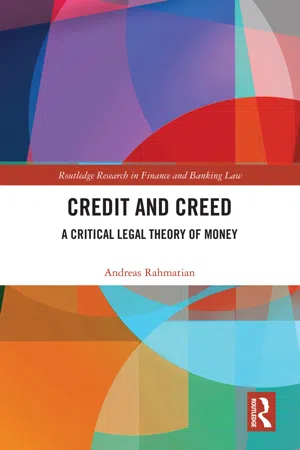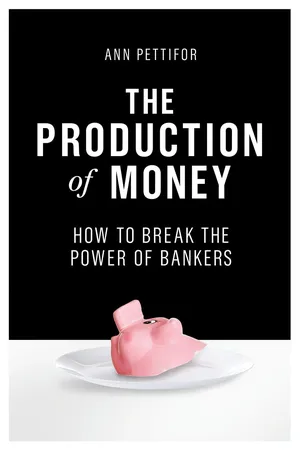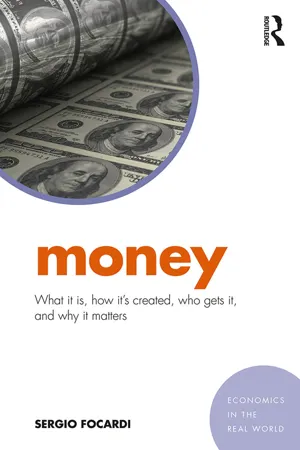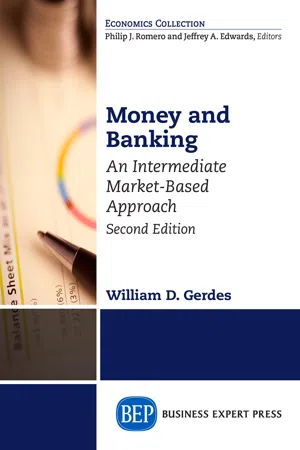Economics
Deposit Creation
Deposit creation refers to the process by which banks generate new money through the issuance of loans. When a bank lends money, it creates a deposit in the borrower's account, effectively increasing the money supply. This process is a key function of the banking system and has significant implications for the overall economy.
Written by Perlego with AI-assistance
Related key terms
4 Key excerpts on "Deposit Creation"
- eBook - ePub
Credit and Creed
A Critical Legal Theory of Money
- Andreas Rahmatian(Author)
- 2019(Publication Date)
- Routledge(Publisher)
31 but it does not explain properly the money creation process and should not be given too much emphasis.27 Bank of England (2014a: 14–15).28 Werner (2016: 370).29 Howells and Bain (2005: 241).30 Bank of England (2014a: 15).31 See e.g. Crowther (1946: 45). See also below under sec. 3(b).(c) Credit creation theory of moneyThe credit creation theory of money denies any correlation between money in depositors’ deposits and money provided by loans and therefore emphasises that banks do not use customers’ deposits to grant loans. In contrast, banks create money by giving credit: ‘Whenever a bank makes a loan, it simultaneously creates a matching deposit in the borrower’s bank account, thereby creating new money’.32 Banks are not financial intermediaries at all, neither individually (financial intermediation theory) nor in aggregate (fractional reserve theory). Schum-peter describes the money creation process in this way:33It is much more realistic to say that the banks ‘create credit’, that is, that they create deposits in their act of lending, than to say that they lend deposits that have been entrusted to them…. The theory to which economists clung so tenaciously makes [depositors] out to be savers when they neither save nor intend to do so; it attributes to them an influence on the ‘supply of credit’ which they do not have.The credit creation theory is not the newest of the three theories of money supply; it can rather be traced back to the nineteenth century and was only eclipsed by the other two theories, particularly after the Second World War. In the eighteenth century, ‘credit’ was still associated with moral ideas of ‘trust’ and ‘confidence’ between businessmen, not just with legal claim or debt, for example in the Essay on Credit by Pelatiah Webster of Philadelphia (1786):34 - eBook - ePub
The Production of Money
How to Break the Power of Bankers
- Ann Pettifor(Author)
- 2017(Publication Date)
- Verso(Publisher)
private banking system. Rather than banks acting as intermediaries and lending out deposits that were placed with them, it is the act of lending itself that creates deposits or bank money, and is also a debt, the Bank’s staff explained. Of course this bank money is not actually printed by the private bank; only the central bank has the legal authority to print money and mint coins. The money created by a loan – bank money – is simply digitally transferred from one private bank account to another. The only evidence of its existence is in the numbers printed on a bank statement. Of the total amount of money created, only a tiny proportion is normally converted into tangible money in the form of notes and coins, or cash.For private commercial bankers operating within a monetary economy, the relevant consideration is not the availability of existing savings, but the viability of the borrower, her project, her collateral and the assessment of whether the project will generate income with which she can repay the credit/debt.And yes, the Bank of England confirmed that in a monetary economy the money multiplier (the percentage of deposits that banks are required to hold as reserves against lending) is an incorrect account of the lending process. Bank lending is not constrained by ‘reserves’. The assumption that banks hold reserves equal to a fraction of their lending – ‘fractional reserve banking’ – is wrong. Bank ‘reserves’ are not savings in the sense we understand them. They are resources (resembling an overdraft) made available only to the bankers licensed by the central bank. They are used to facilitate the ‘clearing’ process for settling deposits and liabilities between banks at the end of each day. Central bank reserves never leave the banking system to enter the real economy. While central bank reserves may help to free up the balance sheets of banks and other associated financial institutions, they cannot be used to lend on to firms or individuals in the non-bank economy. - eBook - ePub
Money
What It Is, How It's Created, Who Gets It, and Why It Matters
- Sergio M. Focardi(Author)
- 2018(Publication Date)
- Routledge(Publisher)
A critical point is that there must be an original distribution of banknotes to the public to allow them to make deposits. How does the public get the banknotes? Most textbooks take it for granted that the public has banknotes to deposit. If central banks can finance the state, the public might get banknotes when performing services for the government. However, in many states, including the U.S., the U.K., and the E.U., central banks are not allowed to lend money to the state directly. If central banks cannot lend money directly to the state, the public (individuals or firms) has no way to obtain banknotes in payment of services. Central banks might use banknotes to purchase assets owned by commercial banks. These assets become reserves of the commercial banks who can then make loans to the public who thereby get banknotes. However, the purchase of large amounts of assets by the central bank is an exceptional measure which cannot be considered the standard way of injecting banknotes into the economy.The vertical approach to money creation is subject to this difficulty: It needs a source of seed exogenous base money to create deposits but it is not clear how individuals and firms can get this seed money if the central bank cannot finance the state.By controlling the amount of reserves and the amount of banknotes issued, central banks can control the amount of money in circulation. This is the key to the verticalist approach: central banks control the stock of money and let interest rates fluctuate.5.4 The creation of bank deposits and endogenous money generation
Though the notion of the multiplier discussed earlier is routinely taught in textbooks on banking and financial economics, it does not correspond to the reality of today’s banking systems. The alternative explanation of today’s banking system and the creation of money – the horizontalist approach – argues that money is created horizontally within the banking system, with the contemporaneous creation of loans and deposits. That is to say, commercial banks can create deposits without actually receiving any exogenous money. - eBook - ePub
- William D. Gerdes(Author)
- 2017(Publication Date)
- Business Expert Press(Publisher)
CHAPTER 4Central Banks and the Money SupplyBanks, Bank Lending, and MoneyCommercial banks are profit-oriented depository institutions. Bank customers place deposits with these institutions, and also use these bank deposits to make payments. That is, banks deposits are used as money. Since the bulk of the money supply resides in commercial banks, banks are often viewed as custodians of our money supply.Commercial banks have an even larger monetary role because they are a conduit for the implementation of monetary policy. Currently, the most common way for the money supply to increase is through bank lending. When a bank makes a loan, the proceeds of the loan are in the form of an increase in the customer’s deposit balance at the bank. Payment in this form is satisfactory to the bank customer because bank deposits are used as money. The customer can now spend this new deposit to purchase the item he/she is financing through credit.The impact of the bank loan on the balance sheet of the bank is shown as transaction 1) in Exhibit 4.1 . Bank A, the lending bank, has an additional loan in its portfolio (Loan +). The offsetting liability entry is the increased deposit balance of the borrowing customer (DD√ +).When Bank A extends credit to a customer in this fashion, the money supply increases. That is because the proceeds of the loan is new deposit money. The aggregate money supply is now higher than it was before. Bank A now holds more deposit money. Every other bank in the system has the same amount of deposit money as before. Changes in the money supply are shown in equation (4.1).M1 (↑) = DD√ (↑) + C (4.1) Exhibit 4.1 Bank LoanThe reason that banks make loans to their customers is that it is profitable to do so. Assume that the interest rate on the loan made by Bank A is 5%. Assume, as well, that DD√ is a noninterest bearing deposit account. The spread on this loan is 5%. If the customer does not default on the loan, this is a profitable transaction for the bank.1
Learn about this page
Index pages curate the most relevant extracts from our library of academic textbooks. They’ve been created using an in-house natural language model (NLM), each adding context and meaning to key research topics.



